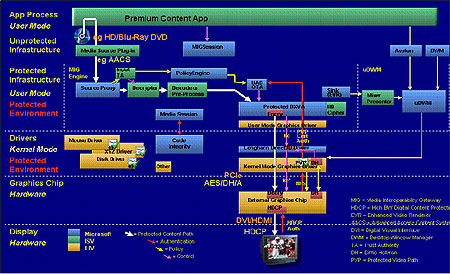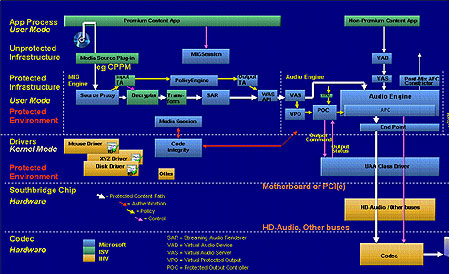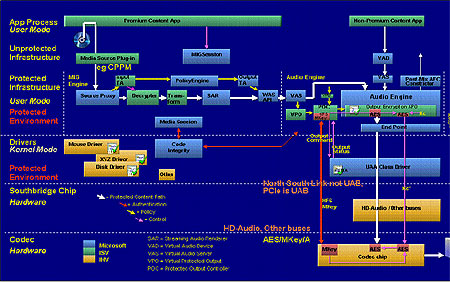Protected Video Path - PVP-UAB - User Accessible Bus is the second aspect of video
control in Microsoft's OCMP suite. It is intended to ensure that information
passing through the system bus cannot be 'snooped' or otherwise copied at the
hardware level by encrypting all 'premium content' media data with a simplified
form of 128-bit AES encryption.

In order to be compliant with PVP-UAB, graphics cards must
incorporate both a unique identifier (which is used in the encryption/decryption
process) and a hardware decryption engine to decrypt the 'premium' data as it is
received from the system bus.
Audio Protection
Protected User-Mode Audio - PUMA
- is Microsoft's projected mechanism for
protecting audio media from the same copying risks that the PVP features cover for
video. License based DRM (Digital Rights Management) systems used by online music
vendors have proven to be quite effective at managing the use of digital music
files, but they do nothing to prevent these files from being digitally copied
in a form which separates them from their license.

PUMA will combine the interface disabling and quality reduction
abilities of PVP-OPM with a 'no-fly' list of restricted software. Under
Windows Vista, audio is run in a separate user process, removed from the system
kernel operations; audio applications and hardware may need a certificate of
approval before they can handle audio under PUMA.
Protected Audio Path - PAP -
is a future audio protection implementation for Vista or later Windows
operating systems. It is not expected to be implemented anytime soon. The main
feature of PAP will be internal encryption similar to that used by PVP-UAB,
which will scramble audio signals as they pass through the system bus between
the media being played and the sound card or audio chip.

It's not clear how this would be implemented with digital
audio files, which we'd expect to be the primary means of playing audio on the
computers of the future.
As you might imagine, the most contentious aspect of
said features is the prospective effect that they will have on users who wish to
play tomorrow's HD DVD disks on their computers. Most computer monitors are
quite capable of displaying HD resolutions, thus making them an ideal home for
HD DVDs. One way or another, we have seen the future, and it is
encrypted.
